RESEARCH
My interdisciplinary research bridges architecture and social sciences to explore how the built environment impacts space-use behaviors, mental health, and psychological bonding with places, particularly focusing on housing. I aim to provide actionable insights that enhance the well-being of residents and the effectiveness of urban spaces.
By leveraging data on residents’ living conditions and histories, as well as their psychological connections to their homes, I create evidence-based designs tailored to the needs and expectations of specific target audiences. This approach helps in understanding the nuanced demands of investment projects and ensures that interventions in urban and residential settings are successful.
My expertise and consulting experience lies in developing comprehensive design guidelines, master plans, and designs for housing and large-scale urban projects. By integrating both material and symbolic aspects of housing, I offer valuable perspectives that align with sustainable planning and user-centered design. My goal is to collaborate on practice-oriented tasks for private and public clients, delivering innovative solutions that enhance both functionality and user satisfaction.
Research interests and experience:
- Residential Satisfaction and Home Conceptualization: Using qualitative and quantitative methods to examine the synergy between residential pressures – and subjective housing measures such as home conceptualizations and place attachment.
- Impact of Housing on Mental Health: Study the relationship between housing conditions and mental health, focusing on stress, well-being, and the effects of high-density living. Use AI-assisted data mining and multivariate models to analyze survey data.
- Cultural and Social Dimensions of Housing: Investigate how cultural, residential, and personal histories mediate psychological bonds with home places. Explore the role of symbolic elements in the conceptualization of home.
- Home and Digital Communications During the Pandemic:
Examine how the meanings of home and experiences of digital communication evolved during the COVID-19 pandemic with the aim of informing disaster prevention strategies. Explore how home became a center of activities, a refuge, and a virtually connected space during the pandemic for some, while the vulnerable population endured important adaptation difficulties. - Teleworking and Home Adaptations: Research the material adaptations made by teleworking mothers during the pandemic. Conduct mixed-methods analysis to identify strategies for creating flexible, supportive home environments for telework.
- Public Policy, Housing, and Scientific Advice:
Examine the impact of public policies on housing and urban development during crises, such as the COVID-19 pandemic. Analyze how state interventions influence housing conditions and social inequalities.
PEER-REVIEWED PUBLICATIONS:
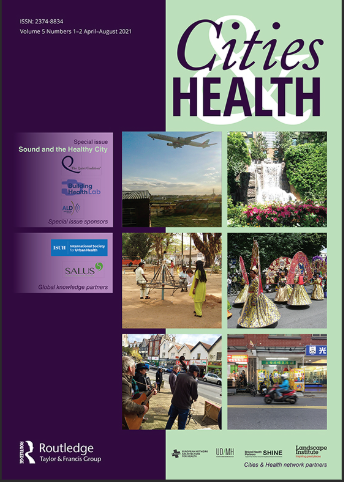
Mental Health and Residential Adaptations during the Pandemic: A Mixed Methods Study of Working Mothers (2025)
Garcia de Paredes, Pablo, and Carole Despres. “Mental Health and Residential Adaptations during the Pandemic: A Mixed Methods Study of Working Mothers.” Cities & Health 1:1–23.
In the Spring of 2020, the COVID-19 pandemic transformed dwellings worldwide into focal points of daily life. This mixed-methods study examines how women in various residential situations adapted when faced with pandemic challenges and how their adaptations influenced the meanings of home and mental health. A pool of 538 working mothers was identified from Quebec’s MAVIPAN repeated measures survey to test if their residential situations, marked by their multiple social roles as mothers, workers, wives, or teachers, and various housing conditions, were associated with mental health and their meanings of home. Four profiles of residential situations were identified through multiple factor analysis (MFA), and 33 women belonging to these profiles were interviewed. Quantitative explorations and ChatGPT-4-assisted thematic analysis revealed conditional associations linking vulnerable residential situations to adaptation difficulties, low mental health scores, and negative feelings toward home, applying to women in blended or single-parent families, in small dwellings, or self-employed.
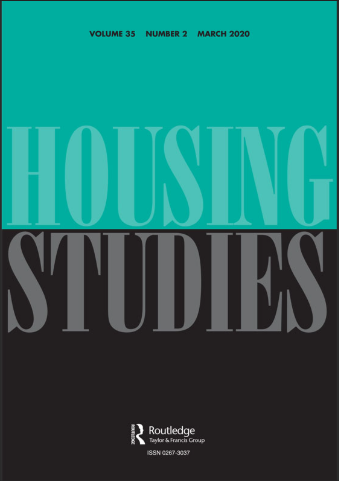
Housing Risk Factors’ Effects on Home Conceptualizations: Exploring the Additive Impact of Residential History
Garcia de Paredes, Pablo. 2025b. “Housing Risk Factors’ Effects on Home Conceptualizations: Exploring the Additive Impact of Residential History.” Housing Studies Journal, Accepted 1–38.
This study explores the intersection of housing risk factors and home conceptualization by examining how factors such as crowding, low housing quality, and residential insecurity influence people’s concept of their actual and ideal homes. We hypothesize that acute residential pressures stemming from housing risk factors lead to altered conceptualizations of home, with residential history amplifying these effects. Conducting semi-structured interviews in the Los Guayacanes node west of Panama City, we used the Housing Pressures Instability Index, HPII, to assess housing risk factors affecting residential experiences, and applied ordinal logistic regression to explore their relationship with participants’ actual and ideal home conceptualizations on a nine-dimension scale. Our results show significant associations in the dimensions of safety, privacy, nature connectedness, and religion, influenced by the combined effects of housing risk factors and residential history. The findings provide new insights into how housing risk factors shape actual and ideal home conceptualizations, contributing to understanding housing’s impact on health, exploring the Latin-American context.
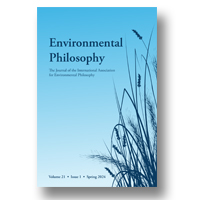
Geosociality: A Theoretical Model of the Meaning of Home Inspired by Clingerman’s Hermeneutics of Place (2025)
Garcia de Paredes, Pablo. 2025. “Geosociality: A Theoretical Model of the Meaning of Home Inspired by Clingerman’s Hermeneutics of Place.” Environmental Philosophy Accepted (Special Issue in Memory of Forrest Clingerman):1–12.
Clingerman’s place hermeneutics offers valuable insights for the interdisciplinary analysis of the construction of the meaning of home. This article builds upon that contribution, developing a theoretical model of meaning-making in residential places, supported by evidence from environmental psychology. Our analysis suggests that the meaning of home, akin to Clingerman’s notion of place, is relationally connected to the concepts of nature and divinity, and that this mechanism underpins the perceptual structure of place meanings. The model integrates deep meanings shaped by everyday practice, emotions reflected in measures of environmental attachment, and home’s multidimensional discourse evidenced by scientific literature.
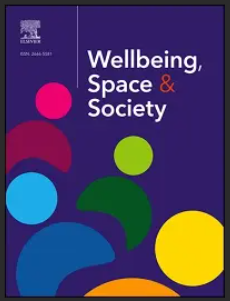
The Contribution of Residential Situations to Mental Health during COVID-19: A Longitudinal Survey (2025)
During the early stages of the COVID-19 pandemic, extended periods of confinement made housing the focal point of daily life. While the impact of sanitary health measures on mental health has been extensively studied, the role of housing remains less understood. Our literature review indicates that housing characteristics and usage patterns influenced mental health outcomes during the pandemic. This study aims to test the hypothesis that the concept of residential situation –an original framework integrating housing attributes, individual and household characteristics, and occupational profiles– is associated with stress, wellbeing, depression, and anxiety measures. We employed data mining techniques and ordinal logistic regression models on a sample of 781 participants from a longitudinal survey conducted in Québec, Canada, between April 2020 and May 2021. Our findings reveal that higher dwelling occupation density is positively associated with increased stress levels. Additionally, apartment living, after adjusting for the number of children under the age of nine, shows a significant association with stress. Feelings of depression and low wellbeing are linked with experiencing separation from loved ones. Also, depression, wellbeing, and anxiety measures were found to be strongly associated with income. This study underscores the effectiveness of a comprehensive framework, applying the interdisciplinary concept of residential situations to capture the nuanced impact of housing on mental health through its links to family dynamics, and shows the importance of social class membership for mental health during crises.
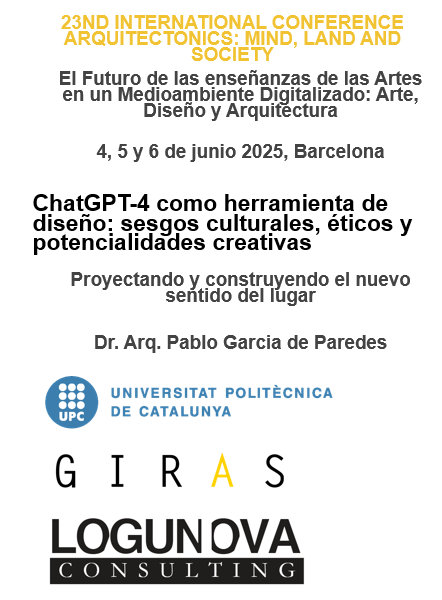
ChatGPT-4 como herramienta de diseño: sesgos culturales, éticos y potencialidades creativas (2025)
Garcia De Paredes, Pablo. 2025. “ChatGPT-4 como herramienta de diseño: sesgos culturales, éticos y potencialidades creativas.” in El Futuro de las enseñanzas de las Artes en un Medioambiente Digitalizado: Arte, Diseño y Arquitectura. Barcelona, España: Universitat de Catalunya.
La incorporación de inteligencia artificial (IA) en el diseño arquitectónico y urbanístico abre un abanico de posibilidades innovadoras, pero también expone limitaciones críticas para su implementación en disciplinas encargadas de crear ambientes para los seres humanos. Este trabajo analiza el potencial de ChatGPT-4 como herramienta de diseño, evaluando sus implicaciones éticas, culturales y creativas a través de cinco conversaciones cuidadosamente estructuradas. Estas incluyen el desarrollo de lineamientos para una nueva tipología escolar y debates sobre la priorización de valores en los procesos de diseño.
El estudio se fundamenta en el paradigma del capitalismo cognitivo-cultural, desarrollado por el geógrafo A.J. Scott, para abordar las dinámicas de creatividad y producción del espacio en las ciudades contemporáneas. Argumentamos que el entrenamiento de la IA refuerza sesgos socioculturales y éticos al replicar sistemas de valores predominantes, lo que puede limitar su capacidad para abordar problemas específicos de contextos locales o desafíos relacionados con escenarios futuros. Este fenómeno plantea un riesgo de homogeneización, promoviendo una globalización sin reflexión a través de un futuro común imaginado. Ambos sesgos diluyen las identidades locales, restringen la posibilidad de imaginar futuros novedosos o alternativos y desconectan a los diseñadores de valores y cosmovisiones profundas. Desde una perspectiva ética, los sesgos culturales de la IA imponen una moral parcial que condiciona su operación. Como consecuencia, el motor de lenguaje natural no puede evaluar objetivamente las limitaciones impuestas por las visiones moderadoras adquiridas durante su entrenamiento, afectando lo que llamamos el “liderazgo imaginario” inherente a las disciplinas creativas.
Sin embargo, ChatGPT-4 también demuestra un notable potencial como herramienta combinatoria, sugiriendo soluciones no convencionales al diseñador, siempre que este cuente con suficiente experiencia y conciencia de sus limitaciones. Estas capacidades enriquecen los procesos tradicionales. Nuestro análisis interdisciplinario destaca tanto los obstáculos como las oportunidades que plantea la IA, abriendo un debate necesario sobre su impacto en la creatividad y la práctica del diseño en un mundo globalizado.
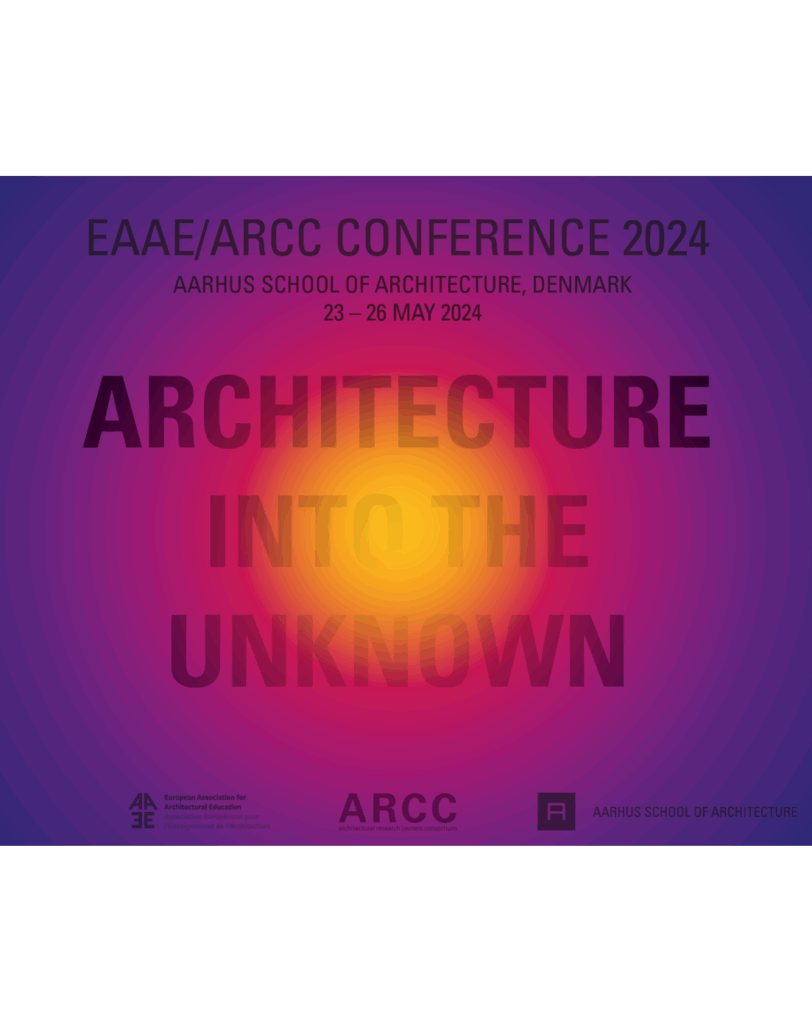
Artificial Intelligence-Assisted Thematic Analysis: A Contribution to Architectural Research (2024)
Duval, Estelle, Catherine Chouinard, Pablo Garcia de Paredes, and Després Carole. 2024. “Artificial Intelligence-Assisted Thematic Analysis: A Contribution to Architectural Research.” Accepted- Conference Paper 1–31.
Architectural research involves comprehensive analysis of diverse data, including user satisfaction data, interview excerpts, plans, and photographs. Analyzing such qualitative material is costly and time-consuming. While architectural programming firms often use qualitative data analysis software, many practitioners rely on informal methods. This article explores AI-assisted content analysis by comparing it with human-centered analysis in two case studies. Efficiency, accuracy, and replicability were evaluated as key criteria. Case Study 1 utilized openended responses from a survey of 356 school staff about school premises, informing design guideline development for public school renovations in Quebec, Canada. Case Study 2 analyzed 33 interviews with teleworking mothers involving architectural plans, dwelling photographs, and participant profiles aimed at enhancing home office environments. The human-centered analysis included manual transcript splitting and coding, alongside reviewing photographs and plans. Our findings show that AI-assisted analysis excels in efficiently disassembling and reassembling data, while having some shortcomings in compiling and interpreting data. It also demands considerable expertise in prompt formulation, which hinders accuracy and reliability. Human-centered analysis, although inefficient, requires data familiarity, knowledge of evidence, and research experience. All three are absent from the models’ training. In conclusion, the potential of artificial intelligence to streamline qualitative analysis is discussed.

Rethinking The Home Office: Insights From Teleworking Mothers’ Material Adaptations During COVID-19 (2024)
Garcia de Paredes, Pablo, Carole Despres, Marie Baron, and Annie LeBlanc. 2024. “Rethinking The Home Office: Insights From Teleworking Mothers’ Material Adaptations During COVID-19.” Accepted- Conference Paper 1–31.
This follow-up qualitative study delves into the contribution of housing on the material adaptations of teleworking mothers during the COVID-19 pandemic. The investigation concentrates on the interplay between housing conditions, the multifaceted challenge of daily routines faced by mothers, and telework setups during stay at-home orders. Insights from the adaptation process will inform flexible design criteria for home offices in the context of a global telework upsurge and enhance preparedness for future emergencies. Narrative accounts were gathered through 33 semi-structured Zoom interviews of teleworking mothers, supplemented by annotated architectural plans. AI-assisted discourse analysis using ChatGPT-4.0 was conducted on four groupings defined by comparable residential situations (defined along housing attributes, family structure, and work modality profiles). Floor plans, dwelling pictures from home offices or multifunctional spaces, participant profiles, and interview extracts were used for a thorough architectural assessment and for uncovering each group’s material adaptations. The findings were subsequently verified through qualitative analysis. Key design strategies for future housing projects and renovations to improve work modality transitions and telework productivity, especially when living in apartments or with small children, are the inclusion of flexible multifunctional rooms, quiet areas with foldable desks, portable home office setups for the self-employed on the move, small home offices for occasional meetings in sub-utilized storage rooms, modular and soundproof partitions temporarily separating open plans or shared home office spaces, visual partitions to demarcate private and work environments, designing office spaces in intermediate and exterior areas like verandas and balconies through the inclusion of glassed perimeters for winter use, and planning adaptable building systems.
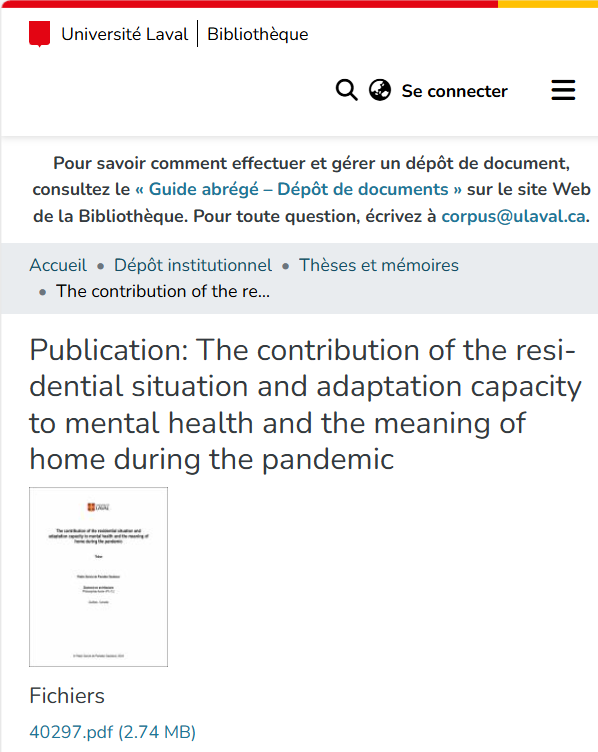
The contribution of the residential situation and adaptation capacity to mental health and the meaning of home during the pandemic (Doctoral Thesis, 2024)
Garcia de Paredes, Pablo, Carole Després, Thierry Ramadier, and d’architecture Université Laval Faculté d’aménagement d’art et de design. “The contribution of the residential situation and adaptation capacity to mental health and the meaning of home during the pandemic.” Doctoral Thesis, Université Laval, Québec.
The COVID-19 crisis placed housing at the center of daily life and provided a relevant context for understanding the impact of its physical and symbolic elements on mental health. It offered the opportunity to study both acute crisis moments during lockdowns and periods of normalcy in the years that followed. This thesis contributes to understanding the influence of housing on mental health by connecting three key factors of the relationship between people and housing: (1) the residential situation, defined by material, socio-economic, and employment factors; (2) adaptations to exogenous forces, such as a pandemic; and (3) mental health. Chapter 1 outlines the organization of the research and its objectives. Chapter 2 presents a literature review on the experiences and meanings of home before and during the COVID-19 pandemic, aiming to examine the transformation of the person-housing relation and to strengthen the resilience of the housing stock. Chapter 3 outlines the theoretical and methodological framework. A three-phase research protocol using mixed methods, including quantitative analysis, a mixed-methods analysis, and a follow-up qualitative study, was planned based on the longitudinal web survey “My Life and the Pandemic in Quebec” (MAVIPAN) (2020-2023). Chapter 4 presents a quantitative study on the contribution of the material characteristics of housing to mental health, using data exploration techniques assisted by AI and multivariate models. The DASS-21 and WEMWBS scales were used to measure mental health. The results suggest that housing occupation density affects stress, with living in an apartment with children under nine years old also being associated with stress. All mental health measures are strongly associated with income. Residential situations have direct effects on mental health, mainly through stress outcomes. Chapter 5 analyzes how adaptation difficulties are linked to vulnerable residential situations and how this impacts the sense of home and mental health. The responses of 538 teleworking mothers from the MAVIPAN survey, along with 33 semi-structured interviews, were analyzed using multiple factor analysis and thematic analysis with ChatGPT-4. The results show that being self-employed or living in an apartment amplifies the impact of housing variables on mental health, often associated with negative meanings of home. During confinements, housing emerged as a gendered space where women took on more family responsibilities and an increased domestic workload. In Chapter 6, a spatial and qualitative analysis explores how housing accommodated the material adaptations made by these 33 teleworking mothers during the pandemic. The data comes from the analysis of interview transcripts, architectural plans, and housing photos provided by the women. The analysis identified various strategies for adapting spaces. Based on these results, design guidelines were developed to facilitate the transition to telework for women living in apartments, small dwellings, with young children, or who are self-employed, notably through flexible rooms, quiet zones, retractable or portable desks, and soundproof partitions. Overall, the results of this research demonstrate how, in a crisis, the physical and symbolic characteristics of housing influence behavioral and material adaptations, as well as the experience, perceptions of home, and mental health.
Garcia de Paredes, P. (2022c, November 27): L’avenir du climat, c’est la ville carboneutre
L’avenir du climat, c’est la ville carboneutre. Le Journal de Québec.
Garcia de Paredes, P. (2021c, November 22): À quoi serviront les grands projets en 2050?
À quoi serviront les grands projets en 2050? Le Journal de Québec.
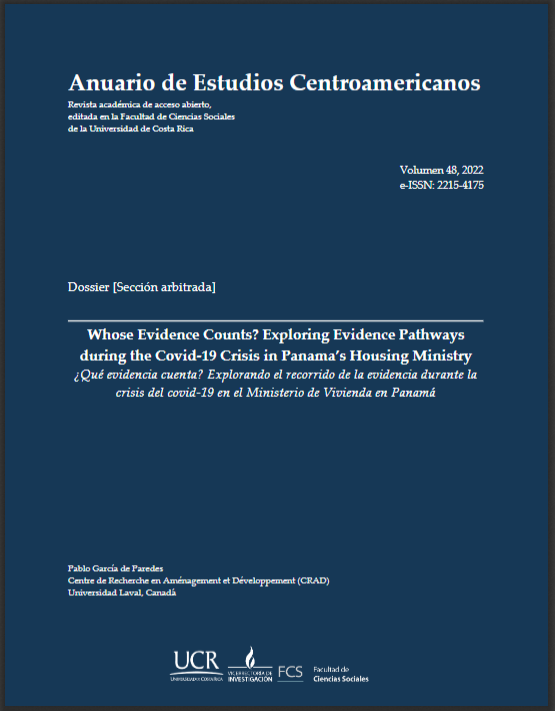
Whose Evidence Counts? Exploring Evidence Pathways during the Covid-19 Crisis in Panama’s Housing Ministry (2022)
Garcia de Paredes, Pablo. 2022. Whose Evidence Counts? Exploring Evidence Pathways during the Covid-19 Crisis in Panama’s Housing Ministry. Anuario de Estudios Centroamericanos, 48(2022).
This paper explores how is evidence gathered, transformed, and selected during the current COVID-19 crisis, employing Panama’s housing ministry as a case study. We wish to better understand evidence pathways and provide strategies for increasing scientific evidence uptake. Our research strategy was organized into a three-step sequential model: 1. The evidence-gathering phase: we studied Covid-19’s effects on households by deploying 135 surveys (n=135). 2. The evidence transformation phase: studying housing sector evidence assembled by different ministry divisions via 12 surveys and interviews with ministry personnel (n=12), and 3. The evidence selection phase: studying evidence employed by decision-makers, through a semi-structured interview with the housing minister (n=1). Results show that evidence pathways depend on social phenomena, including internal and external political power negotiations, social class identities, and representations of the role of government.

Universités, Complexité et Politiques Publiques en Temps de Crise (2022)
Garcia de Paredes, Pablo. 2022. “Universités, Complexité et Politiques Publiques en Temps de Crise.” Revue internationale du CRIRES : innover dans la tradition de Vygotsky 5(2):19–35. doi: https://doi.org/10.51657/ric.v5i2.51179
La pandémie de Covid-19 a permis de mettre en évidence les forces et les faiblesses des institutions sociales lorsqu’il s’agit de fournir des informations à l’État pour la résolution des crises. Comment est organisé le système d’information sur les politiques publiques dans les pays des Amériques et quel rôle jouent les universités ? Cet article théorique cherche à répondre à cette question et à explorer la possibilité d’un changement de paradigme pour le rôle de l’université au niveau continental. La méthodologie que nous avons adoptée est exploratoire : nous comparerons les cas publiés dans les médias numériques dans les deux régions où les universités ont été impliquées dans l’étude des phénomènes déclenchés par la crise du Covid-19. Nous analyserons ces expériences à la lumière de deux systèmes : le système de création d’informations pour les politiques publiques et le paradigme historico-culturel du développement humain. Les résultats de notre analyse montrent que l’université contemporaine peut bénéficier d’un élargissement de son rôle institutionnel. Cet élargissement permettrait aux universités d’entreprendre deux actions stratégiques face aux principaux obstacles que nous avons identifiés : (1) renforcer leur offre académique face à des facteurs qui vont à l’encontre de l’enseignement supérieur et (2) créer une plus grande compatibilité entre les connaissances générées au sein des universités et l’utilisation qui peut en être faite par les décideurs.
Poster presentation: This video corresponds to the presentation of a Poster at the Mavipan Symposium 2023. Both the video and poster were created for the event. Their content is informed by the findings of my doctoral thesis at Université Laval.
Communicating public policy: As part of the effort to get the support of ministers and VIP stakeholders around the approval by the National Assembly of Panama of the National Land Management Law, this video and the communication content were made by me for the company EPYPSA, a consulting services provider for the Inter-American Development Bank IDB.


